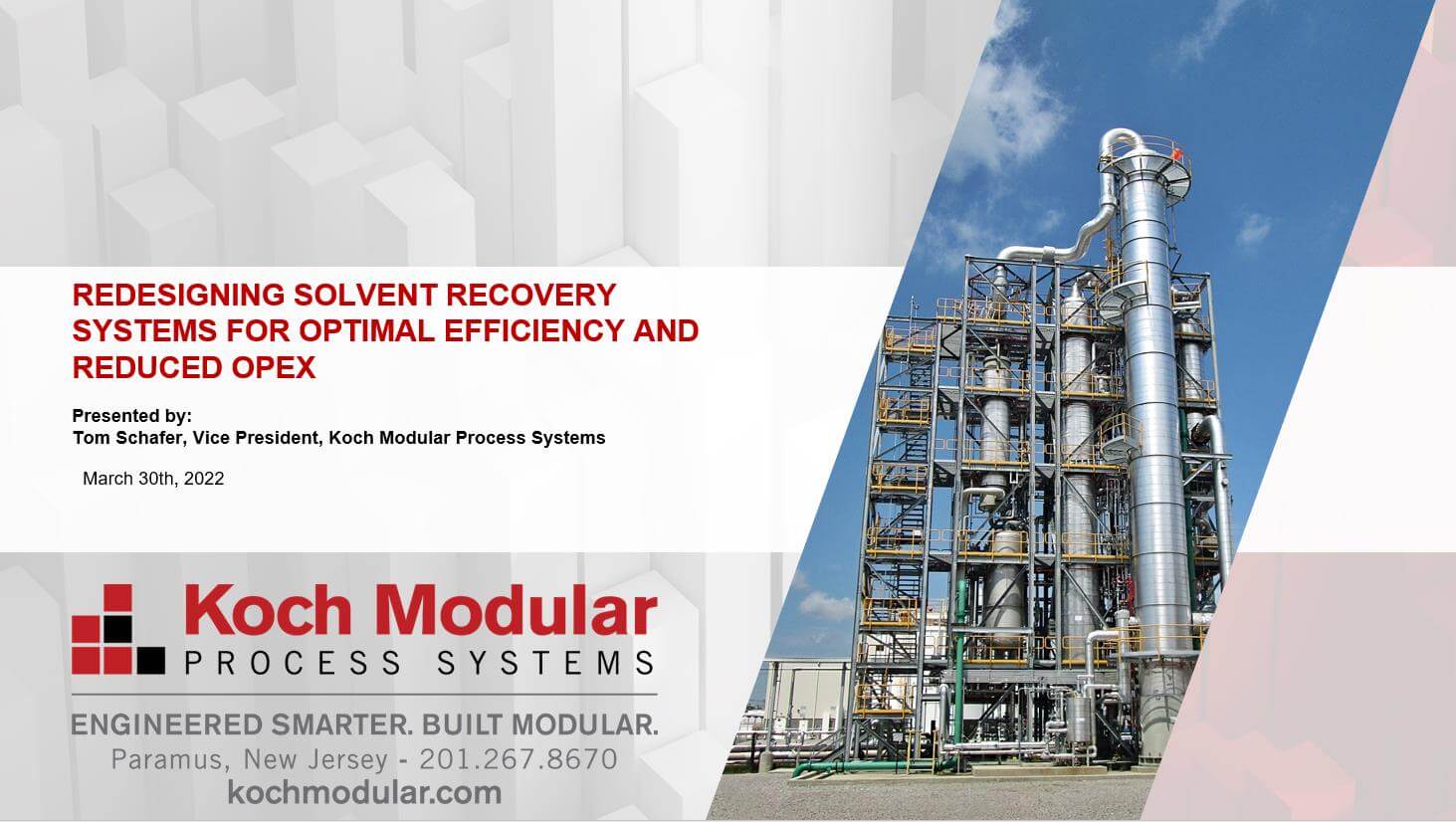Redesigning Solvent Recovery Systems For Optimal Efficiency And Reduced OPEX

Solvent recovery, also known as solvent recycling or solvent reclamation, is often a critical economic factor in determining the feasibility of a new project or plant expansion. Environmental regulations, new solvent costs and waste disposal costs can easily exceed the cost of solvent recovery equipment and operation.
Access a free recording of our live webinar to strengthen your understanding of current methodologies and technologies employed to design sustainable solvent recovery systems. In this webinar, Tom Schafer, Co-Founder and Vice President of Koch Modular, discusses how these systems allow operators to improve efficiency and sustained performance in an environmentally conscious manner while reducing operating costs, solvent inventory, waste disposal, and overall liability.
Presentation Highlights:
- Major benefits of solvent recovery
- Correct sequencing for technoeconomic viability evaluations
- Real-world examples and lessons learned:

Access a free recording of our live webinar on sustainable solvent recovery systems
Meet the Presenter

Tom Schafer is Co-Founder and Vice President of Koch Modular and has over 45 years experience in process design, operations management, cost estimating, and plant layouts. Specific expertise in equipment design, including distillation, heat transfer, fluid flow, and process control.
Tom holds a B.S. in Chemical Engineering and an M.S.in Chemical Engineering from Manhattan College.
- Phone: 201-267-8665
- Email: thomas.schafer@kochmodular.com
Webinar Q&A
Compiled below are real questions webinar participants provided during our live session accompanied by detailed answers from industry expert, Tom Schafer.
Evaporation is used when solvent is being recovered from a solution where the solute is non-volatile. When the solute is volatile then distillation will be required.
LLE is used to break azeotropes or to recovery solvents that are in solution with water and are higher boiling soluble compounds
We use batch solvent recovery for systems where the quantities being processed are small to moderate and where there are multiple components in the mixture, which in a continuous process requires multiple distillation columns in series
Yes, this is fairly common in the pharmaceutical industry where various API's are produced in campaigns and a single multipurpose solvent recovery system treats multiple solvent streams. This will require a lot more engineering because of the number of processes that need to be evaluated.
Capacity increase of a distillation system can possibly be achieved by changing equipment or possibly by changing column internals.
When the solvent is a higher boiler than the solute then you would use back extraction.
Yes, we have worked on rare earth metal separations using Liquid-Liquid Extraction
It is best to put the effort in and determine all of the species that can be present in the solvent mixture before going to the conceptual design stage, otherwise you risk the chance of having to completely redo the design.
The largest diameter distillation column that can be fit inside of a road transportable module in the United States is about 78 inches in diameter
We look at each application as a unique problem. For higher flow rate distillation processes, we can usually justify the added equipment, piping and controls needed to accomplish the lower energy consumption goals. We have a lot of experience with heat integration techniques and we evaluate for each application which technique(s) make the most sense.
Usually +/-25-30% would be the accuracy of a budgetary cost estimate
We would try using antifoams if possible to stop the foaming. If we are not allowed to introduce an antifoam then we would avoid using trays in the distillation column and just use packings.
We use membranes in special applications, like drying of solvents to overcome azeotropes. Membranes are good for small to modest size flow rates.
Yes, we have dried MEK, acetone, MIBK.
The Process Engineering Department would be responsible for the recovery of NMP.
I would expect vacuum distillation would be used.